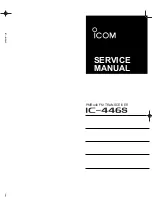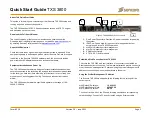
Interpreting LED Indicators
There are four diagnostic LED indicators provided on the
transceiver to indicate the operation status as below:
LED
Operation status State Interpretation
Link
Cable link status
On
The cable link is ok
Off
No cable link or the link is
faulty.
Blink
The cable link is faulty.
TRX
Transmission status Blink
Transmission is in operation.
Off
No transmission.
On
Normal, if large transmission is
in operation.
Problem, if no transmission.
RCV
Receiving status
Blink
Receiving data packet
Off
No packet is being received.
On
Normal, if heavy traffic load.
Problem, if no network traffic.
COL
Collision status
Off
No collision occurs.
Blink
There is presence of collisions.
Installation
Attaching to an Ethernet device via an AUI cable
The Ethernet device can be a network interface controller,
wiring concentrator, or repeater that provides an AUI port.
For attaching to such device, an AUI cable of appropriate
length is required. The following figure illustrates the
connection of the transceiver and an Ethernet device via
an AUI cable.
Important:
If the transceiver is attached to an Ethernet repeater, a
10Base-T hub, or a wiring concentrator, the SQE test
function should be disabled.
Connecting to a fiber optic cable segment
The transceiver has two ST female connectors for hooking
up to a duplex fiber optic cable segment. One ST connec-
tor is used for transmitting data and the other one is used
for receiving data. Two fiber optic cables are required to
compose a duplex cable segment between the transceiver
and the Fiber Optic port at the other end of the cables.
The Fiber Optic port at the other end of the cables must
comply with IEEE 802.3 10Base-FL standard.




















